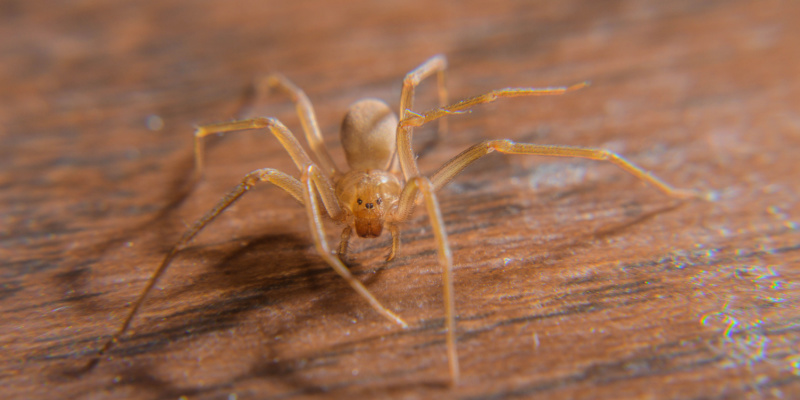Have you ever wondered about the eight-legged inhabitants lurking in your own backyard? If you reside in Northern Kentucky, it’s time to uncover the secrets of its spider population. From tiny jumping spiders that can leap three times their body length to fearsome black widows with venomous bites, this article will be your guide to understanding and identifying the most common spiders in this region. Get ready to spin a web of knowledge as we delve into the world of these creatures.
1. Common House Spider (Parasteatoda tepidariorum)
The common house spider is, as the name suggests, a frequent guest in homes throughout Northern Kentucky. These spiders are generally small, with brownish-gray bodies and long, slender legs. They are known for their intricate, tangled webs that serve as traps for flying insects. Common house spiders are harmless to humans and are, in fact, beneficial as they help control other pests in your home. You’ll typically find their webs in corners, closets, and undisturbed areas.
2. Brown Recluse Spider (Loxosceles reclusa)
While less common than the house spider, brown recluse spiders do inhabit Northern Kentucky. These spiders are known for their violin-shaped marking on their cephalothorax. They often hide in dark, sheltered areas. Brown recluse spiders are venomous and can deliver a painful, necrotic bite, making them one of the more concerning species in the region. However, encounters with them are relatively rare.
3. Black Widow Spider (Latrodectus mactans)
Black widow spiders are another venomous species found in Northern Kentucky. They are identifiable by their shiny black bodies and a characteristic red hourglass shape on the underside of their abdomen. Black widow spiders are well-known for their venom, which can lead to severe health issues if bitten.
4. Wolf Spider (Lycosidae Family)
Wolf spiders are robust, hairy arachnids frequently seen in Northern Kentucky. They are active hunters, relying on their speed and agility to capture prey rather than spinning webs. Wolf spiders have excellent vision and are often spotted roaming around homes, gardens, and grassy areas. These spiders can be quite large and intimidating in appearance, but they are harmless to humans.
5. Orb Weaver Spiders (Araneidae Family)
Orb weaver spiders are known for their beautiful, symmetrical, and intricate webs. They come in various species and sizes, but they all share the characteristic round shape of their webs. While they may appear intimidating because of their size, orb weaver spiders are not dangerous to humans. They typically hang their webs in gardens, trees, or tall grasses.
6. Jumping Spiders (Salticidae Family)
Jumping spiders are small, agile arachnids known for their remarkable jumping abilities. They have massive, front-facing eyes, which give them excellent vision. These harmless spiders are usually colorful and have distinctive patterns on their bodies. Jumping spiders can often be seen on walls, windows, or indoor spaces.
7. Crab Spiders (Thomisidae Family)
Crab spiders are another group of common spiders in Northern Kentucky. They are named for their crab-like appearance, with wide, flattened bodies. These spiders are often found in flowers, where they wait for insects to approach before pouncing on their prey. Crab spiders come in a variety of colors, making them well-camouflaged while hunting.
8. Daddy Longlegs (Pholcidae Family)
Daddy longlegs, also known as cellar spiders, are recognizable by their small, oval bodies and exceptionally long, delicate legs. While they may resemble other spiders, they are not true spiders and lack venomous fangs. Daddy longlegs are commonly found in dark, damp areas like basements and cellars and are harmless to humans.
Preventing Venomous Spider Encounters
While most spiders are harmless, some can deliver painful or even dangerous bites. To reduce the risk of encountering venomous spiders like brown recluse and black widow spiders:
1. Shake Out Shoes and Clothing
One of the most effective ways to prevent venomous spider encounters is by diligently shaking out your shoes and clothing before putting them on. Spiders, particularly species like the black widow or brown recluse, often seek shelter in dark and secluded places such as shoes and folded clothing.
2. Inspect Bedding and Bedding Linens
While it may sound alarming, taking a few simple steps to inspect your bedding and bedding linens can help prevent these unwelcome visitors from creeping into your sleep sanctuary. Start by lifting up your mattress and checking for any signs of spider webs or egg sacs. Also, examine the corners and crevices of your bed frame, as well as any nearby furniture, for any hiding spots that spiders may use. Regularly launder your linens in hot water to kill off any potential tiny inhabitants.
3. Exercise Caution When Working in Basements and Attics
When it comes to preventing venomous spider encounters, one often overlooked area is the basement or attic. These spaces are notorious for providing shelter to spiders seeking dark and secluded places to build their webs. One proactive step you can take is to wear appropriate protective clothing, such as long-sleeved shirts, pants, and gloves. Additionally, be mindful of any cracks or crevices where spiders may enter from outside and seal them off using silicone caulk or weatherstripping.
In conclusion, Northern Kentucky is home to a diverse community of spiders, each with unique characteristics. Understanding the most common spiders in the region can help you differentiate between harmless species and those that may pose potential risks. If you have concerns about spiders in your home or business, it is advisable to contact a professional pest control service like Perfection Pest Control. Don’t hesitate to reach out for expert assistance in dealing with spider issues in Northern Kentucky.
